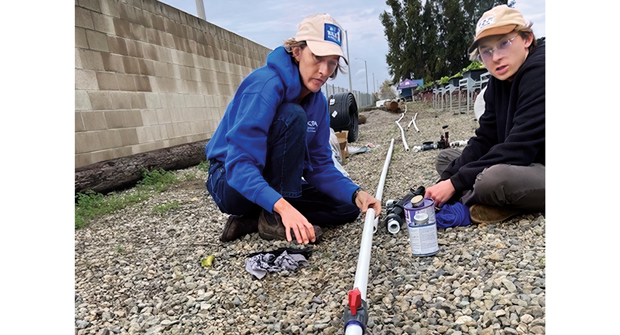Max Moreno, director of technology and water management for Everthrive Landscape Co., says the opportunity for this project came from his relationship with Hannah Standerfer, farm manager at the Second Harvest Food Bank in Irvine, Calif.

Standerfer previously worked with Moreno as an intern at Bemus Landscape, in San Clemente, Calif., where Moreno served as the director of water conservation for several years.
“(Second Harvest Food Bank) had some land from the (University of California) South Coast Research and Extension Center,” Moreno says. “I got together with them and a distributor to donate my time and expertise so that we can create these drip beds so that they can produce fresh vegetables (for the community.)”
Moreno says Hunter Industries and Imperial Sprinkler Supply, an irrigation distributor with locations in Southern California, aided with the project by donating materials, including a solar-powered irrigation controller from Hunter.
“Now (the food bank) is cultivating a lot of fresh vegetables on 93 raised beds throughout the property. It’s going to help a lot of these low-income families to have nutritious food for the community,” Moreno adds.
Moreno and his team of volunteers utilized Netafim Techline drip lines and Hunter valves for the raised beds. The project utilizes both potable and recycled water supplied by the Irvine Ranch Water District.
Even with all the help, the project was not without challenges. Moreno says getting the water from the source to the beds was among the most challenging problems he and his team faced.
“It’s a really large open space, so getting the water from the point of connection from where it is street side to where these raised planter beds was a bit of challenge,” he says. “We used a bit of irrigation equations to figure out pressure and elevation changes.”
The entire process took around a month, Moreno says, with help from community volunteers — many of whom had no previous experience with drip irrigation installation.
“I had to educate the volunteers on how to do drip installation,” he says. “So not only was it an installation, but it also ended up being used as a class on how to install a drip irrigation system.”
Not only did Moreno see the installation as an opportunity to help those in need, it served as a way to potentially introduce volunteers to the idea of a career in irrigation.
“Every time we do anything with irrigation, not only do we talk about how we got our start and how it’s a potential career path,” he says. “It also helps (homeowners) to understand why it’s actually really important to pay attention to their irrigation systems. That’s always one of my driving points in any kind of situation like this.”


